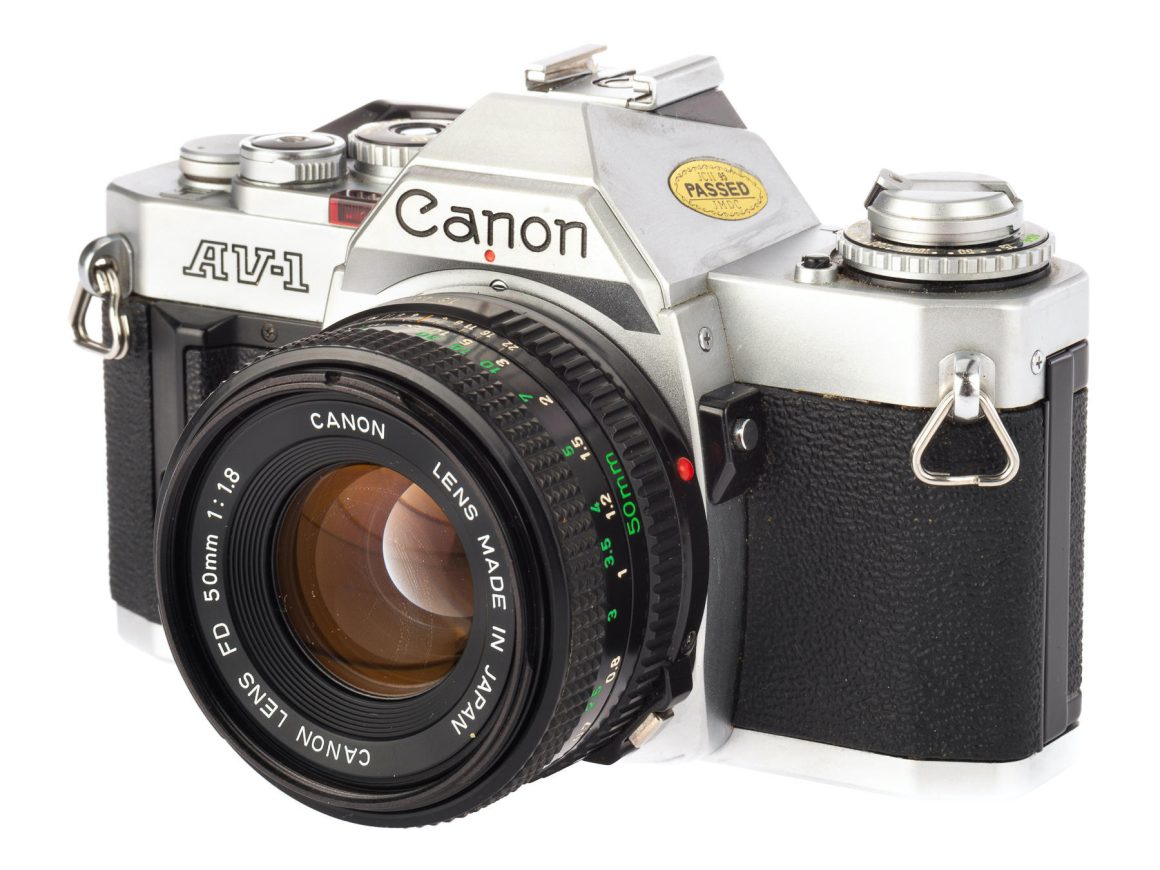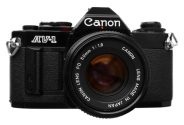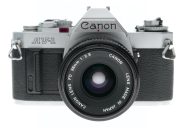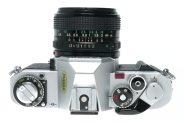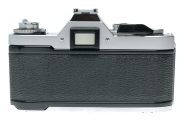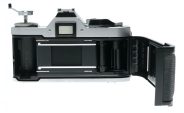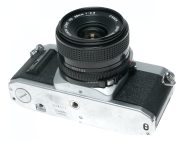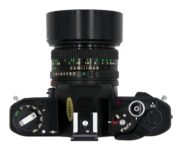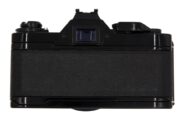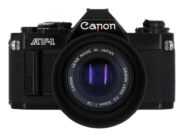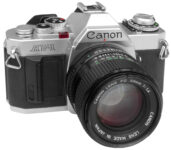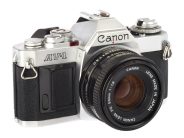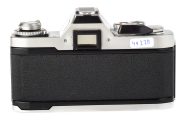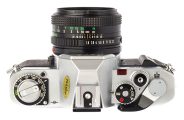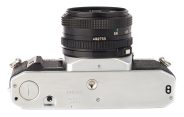Canon AV-1
35mm MF film SLR camera
Specification
| Production details: | |
| Announced: | May 1979 |
| System: | ● Canon FD (1971) |
| Format: | |
| Maximum format: | 35mm full frame |
| Film type: | 135 cartridge-loaded film |
| Mount and Flange focal distance: | Canon FD [42mm] |
| Shutter: | |
| Type: | Focal-plane |
| Model: | Electronically controlled |
| Speeds: | 2 - 1/1000 + B |
| Exposure: | |
| Exposure metering: | Through-the-lens (TTL), open-aperture |
| Exposure modes: | Aperture-priority Auto |
| Manual | |
| Physical characteristics: | |
| Weight: | 512g |
| Dimensions: | 139x85x47.5mm |
Manufacturer description #1
Even though the camera would cost more, shutter speed-priority AE cameras were important to Canon since users could comprehend shutter speeds easier than aperture settings. However, in America and other overseas markets, aperture-priority AE 35mm cameras were in the majority.
Overseas distributors also clamored for an aperture-priority AE model. Canon responded with the AV-1.
When this camera appeared, a new type of FD lenses featuring instant mounting/demounting was also introduced. A low-cost FD 50mm f/2 lens was made available for the AV-1.
Manufacturer description #2
The Canon AV-1 is the perfect answer for the amateur photographer who, though he feels he has graduated from the elementary stage of photography, is daunted by the apparent complexity of SLR cameras. It introduces to such people the greater satisfaction and potential for artistic expression which 35mm photography provides. The AV-1 complements the A-series line-up of A-1, AE-1, and AT-1 and everyone of the A-series models, including the new AV-1, has its own special qualities and features such as shutter priority automatic control, match needle operations, best suited to the photographic needs of your customers.
Just consider what the AV-1 has going for it:
- It's automatic - all you have to do is set the aperture, focus and shoot. Moreover, the AV-1's reliability, durability, excellent performance, and operational efficiency are based on a great deal of technical expertise in electronic control and production process for the reputed A-1 and AE-1.
- It's lightweight, compact and simple in construction, with only 525 parts, or 13% less in the number of parts and 17% less in weight compared to the AE-1.
- It's budget-priced: The AV-1 is one of the less expensive SLRs on the market. To put out a reasonably-priced camera, various selling features have been carefully considered and for the first time the aperture priority method in automatic exposure control is one of the foremost features for a Canon SLR model.
- It can be used with any of the wide range of Canon lenses. So, as your customer becomes more proficient in photography, he'll want to expand his creative horizons. And that means he'll come back to buy more lenses.
Unique Selector Dial makes picture-taking even easier
The user will be amazed at how easy the AV-1 is to operate. Instead of the usual shutter speed dial, there is a Selector Dial which serves as the control for most functions. Now all the photographer has to do is to set the dial to the red A mark (for automatic) before setting the aperture and focusing. In fact, usually you don't have to worry about the dial - just leave it at the A mark, even for flash photography in case of using Canon Speedlites.
In addition to this setting, there are ↯60 setting for any flash other than Canon Speedlites, including other electronic flashes, B (Bulb) for time exposures, and two self-timer settings: (1) A Self for self-timer without flash or with Canon Speedlites, (2) Self ↯ for self-timer with other flashes.
Clear, unobscured viewfinder with full exposure information
The AV-1 's viewfinder incorporates a split image/microprism rangefinder and its exceptional clarity and brightness assure easy, precise focusing.
Besides this, the shutter-speed scale is a mine of information to ensure you obtain perfect results every time. Besides telling you the shutter speed chosen by the camera to correspond to your selected aperture, the needle also provides warning when the battery has run down (when battery check button is pressed). As long as it rises above the index mark located to the left of '30', the battery is OK. What's more, it serves as a good guide as to whether there is a high risk of picture blur.
More than just a camera . .. an entire system
The AV-1 may be one of the simplest cameras to use, but that doesn't mean its potential is limited. There's a whole range of accessories and lenses to meet one's every photographic need. Practically all accessories which can be used for the AE-1 can also be used with the AV-1.
Canon Dedicated Speedlites
Attach any Canon Speedlite to the AV-1 and turn on the power. The Speedlite's electronic circuitry automatically sets the shutter speed to the 1/60 (flash synchronization) setting and varies light output for proper exposure with the working aperture selected on the aperture control ring.
Power Winder A
To keep up with fast-moving subjects, attach the Power Winder A onto the bottom of the camera. Switch it on, press and hold the shutter release button. The film will be wound at about two frames/sec, to capture those fleeting moments. Single-frame shooting is possible too. And since the AV-1 is automatic, there's no problem with exposure.
Manufacturer description #3
Type: 35mm SLR (Single-lens Reflex) camera with electronically controlled AE (Automatic Exposure).
Format 24 x 36mm.
Usable Lenses: Canon FD (for full aperture AE) and most FL (for stopped-down AE) series lenses.
Lens Mount: Canon Breech-lock mount.
Viewfinder: Fixed eye-level pentaprism.
Field of View: 92% vertical and 93% horizontal coverage of the actual picture area.
Magnification: 0.87X at infinity with a standard 50mm lens.
Viewfinder Information: Split-image/micro-prism rangefinder, shutter speed scale and meter needle, red over and underexposure warning indices, battery check/camera shake warning index.
AE Mechanism: Aperture priority AE control.
Selector Dial: Five positions: [A] for normal aperture priority AE and automatic flash with Canon Speedlite 011A, 155A, 166A, 177A, 188A o r199A, 60↯ for flash photography with other flashes, A Self for self-timer with Canon Speedlite 011A, 155A, 166A, 177A, 188A or 199A, Self ↯ for self-timer flash with other flashes, B (Bulb) for time exposures.
Shutter: Cloth, focal plane shutter with four spindles. Electronically controlled.
Shutter Release Button: Electromagnetic, two-step button. Pressing it halfway activates the meter; pressing it all the way sets shutter in operation. With lock and cable release socket.
Exposure Preview: Meter needle activated by pressing the shutter button halfway.
Shutter Speed: Automatically controlled, steplessly, from 2 sec. to 1/1000 sec. Manual settings for B (Bulb) and X-synchronization speed of sec. with flashes other than Canon Speedlite 011A, 155A, 166A, 177A, 188A or 199A.
ASA Film Speed Dial: ASA 25 to ASA 1600. With lock.
Light Metering System: Through-the-lens, Central Emphasis Averaging metering by SPC (Silicon Photocell).
Meter Coupling Range: EV1 (1 sec. at f/1.4) to EV18 ( 1/500 sec. at f/22) with ASA 100 film and the FD 50mm f/1.4 lens.
Exposure Correction: Shutter speed is automatically reduced 1 1/2 steps to increase exposure by pressing backlight control switch.
Mirror: Large instant-return type with shock-absorbing mechanism.
Self-timer: Electronically controlled. Ten-second time lag activated by pressing shutter button. Red LED blinks to indicate operation; flashing frequency increases two sec. before shutter release. Cancellation possible by pressing battery check button.
Flash Synchronization: At 1/60 sec. Set by switching selector dial to 60 ↯ for flashes other than the Canon Speedlite 011A, 155A, 166A, 177A, 188A or 199A. Direct contact at accessory shoe
Automatic Flash Control: With Canon Speedlite 011A, 155A, 166A, 177A, 188A or 199A. With selector dial at [A], shutter speed set to 1/60 sec. automatically. Aperture set manually on aperture ring to same aperture set on flash.
Back Cover: Fixed. Opened by pulling up rewind knob.
Film Loading: Via multi-slot take-up spool.
Film Advance Lever: Single-stroke 120° throw with 30° stand-off. Winding with several short strokes possible. Automatic winding possible with optional Power Winder A.
Frame Counter: Additive type. Automatically resets to "S" upon opening back cover.
Film Rewind: By pressing rewind button and cranking rewind knob.
Power Source: One 6V alkaline-manganese (Eveready [UCAR) No. A544, IEC 4LR44), silver oxide (Eveready [UCAR] No. 544, IEC 4SR44, Duracell PX 28), or lithium (Duracell PX 28L) battery.
Battery Check: Meter needle/power level index method. By pressing battery check button.
